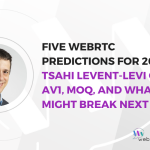
As telehealth applications become more sophisticated, incorporating AI-based features and rich data pipelines for better, accurate diagnostics, the challenge of delivering a flawless, high-quality call experience at scale becomes exponentially more complex. Our team at WebRTC.ventures has been building telehealth video applications since the days when we

Each month, our CEO Arin Sime sits down with long-time WebRTC industry authority Tsahi Levent‑Levi of BlogGeek.me to discuss the latest real-time communications trends and challenges. In their November 2025 session, Arin asked Tsahi five pointed questions and gave him 90 seconds per answer, pushing for clear

The choice between conversation-based and turn-based Voice AI agent patterns is a strategic business decision, not just a technical detail. Beyond what your agent will say, you must decide how it will run. This architectural choice defines how your voicebot will scale, what it will cost to

For the third time, the video froze mid-sentence. The patient, trying to describe a worrying symptom, could only see a static image of her doctor. The promise of convenient, accessible healthcare was quickly turning into a frustrating, stressful experience for both parties. This scenario is an all-too-common






